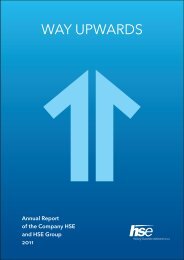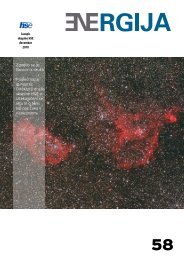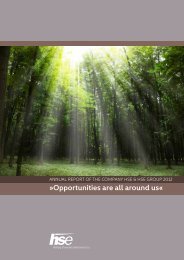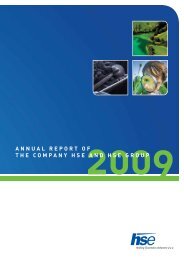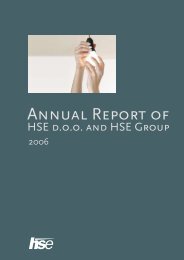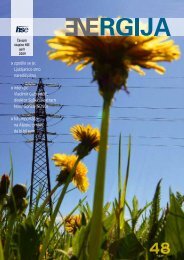ANNUAL REPORT - HSE
ANNUAL REPORT - HSE
ANNUAL REPORT - HSE
You also want an ePaper? Increase the reach of your titles
YUMPU automatically turns print PDFs into web optimized ePapers that Google loves.
<strong>ANNUAL</strong> <strong>REPORT</strong> <strong>HSE</strong> | FINANCIAL <strong>REPORT</strong> OF THE COMPANY <strong>HSE</strong><br />
An item of intangible fixed assets is initially carried at<br />
cost. The cost also includes import duties and nonrefundable<br />
purchase taxes. The cost does not include<br />
interest incurred prior to the origination of an intangible<br />
asset.<br />
After recognition, intangible assets are measured using<br />
the cost model.<br />
Their value is subsequently lowered by the amount of<br />
amortisation recorded in the accumulated amortisation<br />
account. In the balance sheet, intangible assets<br />
are recorded at the carrying amount, i.e. as the difference<br />
between the cost and accumulated amortisation.<br />
An item of intangible assets is amortised individually<br />
using the straight-line amortisation method. Amortisation<br />
begins when an intangible asset is available for<br />
use. The amortisation rates applied to individual types<br />
of intangible assets are based on their envisaged useful<br />
lives.<br />
Property, plant and equipment<br />
Property, plant and equipment are part of long-term<br />
assets owned by the company and used for the performance<br />
of its registered activities.<br />
An item of property, plant and equipment is initially<br />
recognised at cost, which comprises its purchase<br />
price, import duties and non-refundable purchase<br />
taxes, as well as directly attributable costs of bringing<br />
the asset to working condition for its intended use.<br />
The cost does not include the borrowing costs related<br />
to the acquisition of an item of property, plant and<br />
equipment to bring the asset to its working condition.<br />
The cost does not include costs incurred upon the dismantling<br />
or removing of the items of property, plant<br />
and equipment.<br />
The spare parts of higher value are recorded as property,<br />
plant and equipment and depreciated over the<br />
useful life of the related asset.<br />
Following recognition, the items of property, plant and<br />
equipment are measured using the cost model.<br />
In the bookkeeping records the cost and accumulated<br />
depreciation of items of property, plant and equipment<br />
are recorded separately, whereas in the balance<br />
sheet they are recorded at carrying amount, i.e. as a<br />
difference between the cost and accumulated depreciation.<br />
Subsequent expenditure on an item of property, plant<br />
and equipment increases its cost when it increases<br />
its future economic benefits in excess of the originally<br />
assessed future economic benefits.<br />
Recognition of an item of property, plant and equipment<br />
in the bookkeeping records and the balance<br />
sheet is reversed if an asset is disposed of. The difference<br />
between the net selling price and the carrying<br />
amount of a disposed of item of property, plant and<br />
equipment is recorded as revaluation operating revenue<br />
or expense.<br />
The depreciation of property, plant and equipment<br />
items begins on the first day of the month following<br />
the month in which an item becomes available for its<br />
intended use. Depreciation is accounted for individually<br />
on a straight-line basis. The depreciation rates<br />
applied to the individual types of property, plant and<br />
equipment are based on their envisaged useful lives.<br />
Investments<br />
Investments are considered as the company's assets,<br />
the return on which is used to increase the company's<br />
finance income. Upon initial recognition, investments<br />
are recorded at historical cost plus the costs attributable<br />
directly to the transaction (except for investments<br />
measured at fair value through profit and loss).<br />
In the company's books of account, investments are<br />
recognised based on their settlement date (payment<br />
date).<br />
After initial recognition, investments are carried at<br />
cost in the company’s financial statements (which<br />
also includes investments in subsidiaries and associates)<br />
and are recorded as available-for-sale financial<br />
assets. Because their fair value cannot be determined<br />
(this is not the case with derivatives), they are not revalued<br />
and, consequently, do not affect revaluation<br />
surplus. Any indications of their impairment are determined<br />
on an annual basis.<br />
Based on the envisaged settlement or the reason for<br />
100



